Reull Valles is one of many channels on Mars that appear to have been carved by liquid water sometime in the planet's distant past. The channel, long since dry, has probably been widened over time by slumping and erosion of the valley walls. This image was taken by the Viking 1 Orbiter.
Viking took this picture in 1976. How is it that comments on water carving started only since 2000?
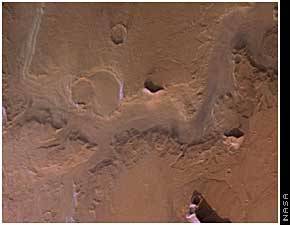
|
One of the many giant canyons discovered on Mars is Candor Chasma, a portion of which is seen in this Viking 1 Orbiter image. Scientists believe that billions of years ago it may have been filled with water. Note the dark areas on the canyon floor; scientists believe these may contain sediments laid down in ancient lakes.
Same comment as above. Moreover, canyons are not caused by lakes, but by flowing waters, when water flows for a sufficient period of time. Lakes appear when there is not enough water anymore to flow across the canyon.
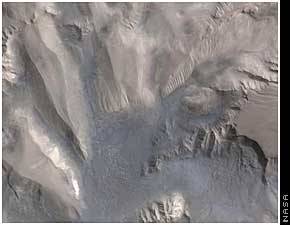
|
The Martian north polar ice cap is largely composed of frozen water. This view of the cap was obtained by Mars Global Surveyor in March of this year, during the Martian northern-hemisphere summer. The cap is roughly 680 miles (1,095 kilometers) across.
Some suggested the pole is made of carbon dioxid ice; but it has been demonstrated since that it really is water ice.
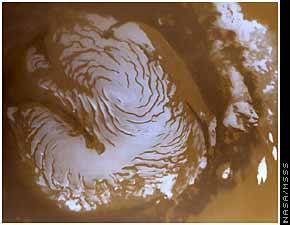
|
The winding channel called Nanedi Vallis was considered an enigma by some scientists, who debated whether the feature was carved by flowing water or was formed by collapse of the surface. This image, from the Viking 1 Orbiter in the late 1970s, also shows the area of the channel photographed in more detail by Mars Global Surveyor more than two decades later.
This is a Viking picture. I find the details were sufficient already!
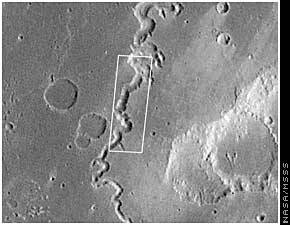
|
Water is present in the Martian atmosphere in trace amounts. But even this small bit of water vapor is enough to produce clouds, seen here over several of the giant Martian volcanoes in the region called Tharsis. The clouds form when air rises up the slopes of each volcano, causing the gases to cool; the water vapor in the air then forms a cloud of ice crystals.
July 2000 comment: soon NASA will discover that there is actually much more water than expected on Mars. We'll see... November 2003 comment: it is now known that the south pole is also made of water ice and not frozen carbon dioxid.
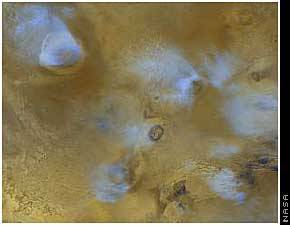
|
Thin Ice: this image taken by the Viking 2 lander in 1979 shows frost on the Martian surface. Scientists believe the frost formed when dust particles in the atmosphere picked up small bits of water ice, then acquired a coating of frozen carbon dioxide (the gas that makes up 95 percent of Mars' atmosphere). The ice deposit seen here is extremely thin, perhaps no more than one-thousandth of an inch (0.002 millimeter) thick.
See the false colours page to get the full story: this image has been red-enhanced like most of Mars images proposed to the general public. Click here to see the original non-coloured NASA image, and maybe you will see a lot MORE ice.
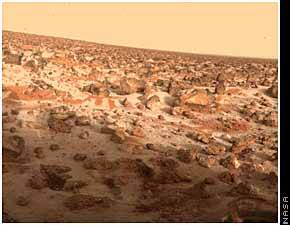
|
The floor of Hrad Vallis, photographed by Mars Global Surveyor, shows the effects of water erosion. Rocky masses have been carved and sculpted by flowing water into streamlined shapes. This picture is about 2.4 miles (3.8 kilometers) across.
Definitely not carved just by a tiny river.
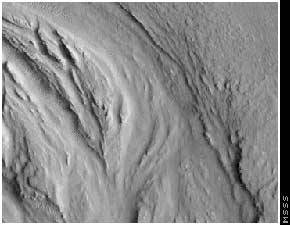
|
This crater, called Yuty, is about 11 miles (17.7 kilometers) across. Yuty is surrounded by a pattern that looks like the petals of a flower. What caused this? Try dropping a pebble onto a dish full of mud: it goes "splosh" and makes a pattern much like the one you see here.
The crater is not very old. It means there is probably still a respectable quantity of underground water.
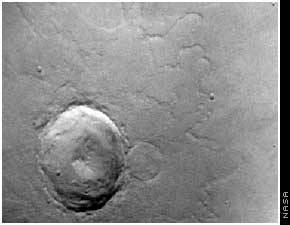
|